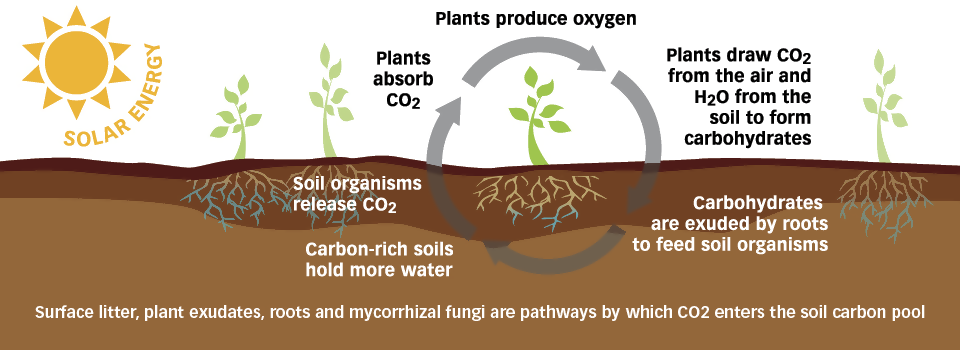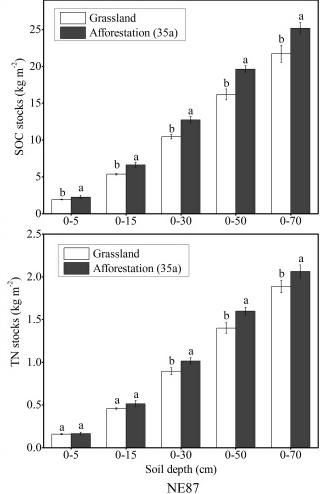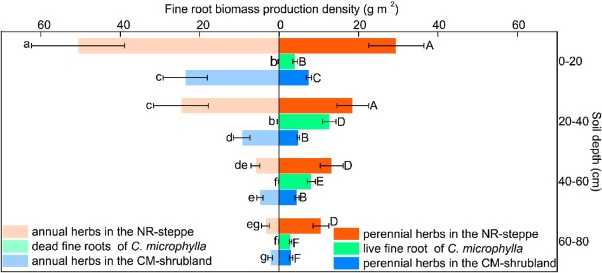October 21, 2020 at 9:33 pm | Updated March 16, 2022 at 11:38 am | 7 min read
Soil carbon is the second-largest carbon sink in the world, and it is currently in focus during these times of accelerating climate change brought about by human activities. Very little is known on the patterns of carbon accumulation in the soil. Thus, it is essential to determine the mode and quantity of carbon being sequestered by afforestation projects to mitigate climate change, not just aerially but also underground. Many scientific field instruments developed for agriculture and general plant research come in handy to measure accumulation of carbon in the ground.
Soil Carbon
A little known fact is that eighty percent of carbon in terrestrial ecosystems is underground. The aerial parts of trees and plants actually store only twenty percent of the carbon captured. This makes soil carbon a valuable sink. There is 3.1 times more carbon in the soil than in the atmosphere, second only to the oceans which contain the most carbon.
However, decades of deforestation and intensive agriculture have been depleting this resource. Besides its value as a carbon sink, carbon is also essential to maintain soil fertility.
Subscribe to the CID Bio-Science Weekly article series.
By submitting this form, you are consenting to receive marketing emails from: . You can revoke your consent to receive emails at any time by using the SafeUnsubscribe® link, found at the bottom of every email. Emails are serviced by Constant Contact
Formation of Soil Carbon
During a process called photosynthesis, plants fix carbon by taking in carbon dioxide through their leaves to produce food. Carbon is present in the compounds that make the stems, leaves, and roots of plants and trees. There is also carbon in the leaf and branch litter that returns dead aerial parts to the soil. Litter and dead roots are decomposed by microbes, fungi, and small insects to add organic matter that has carbon in the ground, see Figure 1.

Figure 1: Formation of soil carbon pools (Image credits: https://www.cecsb.org/rethink-food/carbon-farming/)
Some carbon dioxide in the air dissolves in rainwater and seeps into the ground. For this reason, wet forests and regions with more rainfall can store more carbon in the soil.
While the top portion of the soil has most of the carbon, carbon compounds seep gradually down into deeper layers of the ground, where they can be stored for thousands of years.
Afforestation
While the basics of the carbon cycle are well known, the ecological processes involved in forming and maintaining soil carbon sinks have barely been researched. There is a growing interest in this area since the importance of soil carbon was highlighted some years ago.
The role that above-ground forests play in acting as carbon sinks is well recognized. Afforestation projects have been undertaken all over the world to try and recapture some of the carbon emissions from human activities, such as the burning of fossil fuels, agriculture, and industrialization.
Projects follow different practices or use different local species for afforestation. Research groups are beginning to study the effect that these interventions have on underground carbon pool formation.
Ecological Consequences Measured by Canopy Cover
In China, afforestation was carried out in semi-arid grasslands to restore spruce forests. When they planted Picea crassifolia, the Qinghai spruce, they changed the microclimate and their habitats.
Afforestation altered the soil properties positively. There was a decrease in soil bulk density and an increase in soil water content. There was also an increase in the amount of organic carbon and total nitrogen in the soil to a depth of seventy centimeters from the soil surface. Tests showed that there was also a significant increase in the carbon to nitrogen ratio in the topsoil.
Soil changes were accompanied by transformation in the vegetation in the grassland. While there was an increase in the diversity of herbs, there was a decrease in the percentage of cover of the herbs and their biomass.
One of the tools which were used in the experiment was the CI-110 Plant Canopy Imager, produced by CID Bio-Science for the non-destructive calculation of canopy cover.
This portable tool has a self-leveling camera with a fisheye lens angle of a hundred and fifty degrees and can take hemispherical canopy photographs. The twenty-four PAR (photosynthetically active radiation) sensors along the arm of the probe, record radiation levels. The image by the GAP Fraction Method, which records the light let in by the plant canopy or from the PAR readings, can calculate the lead area index (LAI). Using the LAI and PAR, several canopy parameters can be calculated. The instrument has a GPS, so time-series measurements are also possible.

Figure 2. Comparison of soil carbon (SOC) and total nitrogen (TN) in control and afforested grassland plots, Chen et al. 2016. (Image credits: https://doi.org/10.1016/j.catena.2016.07.009)
This study clearly showed that afforestation with the Qinghai spruce helped in increasing soil carbon pool; see Figure 2.
Quantifying Root Growth to Measure Soil Carbon
The species that are chosen for afforestation can be significant. Not all afforestation projects are as successful as the Quighai spruce project. Another trial, also in China, used the shrub Caragana microphylla in degraded semiarid to arid steppes to restore vegetation.
Shrubs are considered a vital way of restoring steppes.
To check fine root growth, soil carbon storage, and plant composition, the study compared the new shrublands to neighboring steppe that was naturally restored.
The CI-600 In-Situ Root Imager from CID Bio-Science was used to measure the growth of fine roots and quantify their amounts.
The Root Imager is a portable minirhizotron that takes images of roots non-destructively up to a depth of 105 cm. It is inserted into transparent tubes that are installed in the field around which the roots grow. The imager can be turned 360 degrees to get high-resolution pictures. A free software, RootSnap, snaps to the roots differentiating it from the surrounding soil. The software also calculates the root dimensions like length, area, and branching volume.
The Chinese study found that the growth of fine roots of shrubs is less. The total fine root growth in the shrublands of the other herbs was also less than in the naturally restored steppe at all depths from 0-80 cm, as can be seen in Figure 3. The root biomass and soil carbon production was 65.7% and 43.9% less in scrublands than in the steppes.

Figure 3: There is less root growth of shrubs and in scrublands compared to natural steppes, Lai et al. 2017. (Image credits: https://doi.org/10.1016/j.ecoleng.2017.01.001)
Thus, not only is the shrub, Caragana microphylla, inefficient in accumulating carbon, but it is also adversely affecting the capacity of the native vegetation in replenishing soil carbon. Hence, the use of this shrub should not be promoted in steppes.
Nitrogen Fertilization Depletes Carbon Storage
In California, the Mediterranean‐type shrublands, called chaparral, are prone to fires. While most soils accumulate carbon and nitrogen over time, the fires and rapid uptake of nutrients after a fire upset the usual patterns.
California is densely populated, and there is a lot of dry nitrogen deposition, mainly as air pollutants. Since the chaparrals are naturally nitrogen deficient, the addition of this nutrient can change the ecosystem dynamics.
A study fertilized some areas artificially to study the effect of nitrogen on post-fire vegetation. Fresh leaf and stem, soil, and litter samples were collected and analyzed for carbon and nitrogen.
The vegetation parameters, such as LAI and leaf area, were also monitored. The Portable Laser Leaf Area Meter CI-202 from CID was used to measure leaf area non-destructively. The leaf meter uses laser to scan leaves to record the length, width, perimeter, area, and aspect ratio within a few seconds. The device can store 8000 measurements, so it useful for forest studies. The data can be later transferred to the computer through a USB cable.
The scientists found that when the vegetation burns in the initial months, there is an accumulation of carbon and nitrogen as the burnt material decomposes. Up to four years after the fire, soil carbon and nitrogen levels remained high, as it takes time for the new vegetation to grow to the extent that it can use all the available nutrients in the soil. Then the plots that had nitrogen fertilization experienced better growth and showed more aboveground nitrogen and carbon accumulation, with maximum amounts in leaves. Once the vegetation was established, addition of litter and root growth steadily increased carbon in the soil by the end of the first decade after the fire.
More Studies Are Needed
The current soil carbon studies are establishing the basics in each ecosystem and under different treatments. The difference in soil, gradient, rainfall, vegetation type, and species will all affect the sequestration of carbon and its flow in the recovering ecosystems. While any kind of afforestation is better than leaving land in a degraded condition, simple experiments backed with accurate data can increase the efficiency of people’s efforts. Precise tools such as those from CID Bio-Science will increasingly be necessary for scientists and later for foresters to monitor carbon sequestration success.
—
—
Vijayalaxmi Kinhal
Science Writer, CID Bio-Science
Ph.D. Ecology and Environmental Science, B.Sc Agriculture
Featured image courtesy of Sterling College
Sources
Chen, L.F., He, Z.B., Zhu, X., Yang, J.J., & Li, J. (2016). Impacts of afforestation on plant diversity, soil properties, and soil organic carbon storage in a semi-arid grassland of northwestern China. Catena, 147: 300-307. DOI: https://doi.org/10.1016/j.catena.2016.07.009
Fountain, H. (2019, Dec 4). Climate Change Is Accelerating, Bringing World ‘Dangerously Close’ to Irreversible Change. New York Times. Retrieved from https://www.nytimes.com/2019/12/04/climate/climate-change-acceleration.html
Lai, Z., Liu, J., Zhang, Y., Wu, B., Q, S., Sun, Y., Zhang, J., Feng, W., Fa, K., & Bai, Y. (2017). Introducing a shrub species in a degraded steppe shifts fine root dynamics and soil organic carbon accumulations, in northwest China. Ecological Engineering, 100: 277-285. DOI:https://www.sciencedirect.com/science/article/abs/pii/S0925857417300010
Ontl, T. A. & Schulte, L. A. (2012). Soil Carbon Storage. Nature Education Knowledge 3(10):35
Sorensen, E. (2018, Nov 26). Six feet under: Deep soil can hold much of the Earth’s carbon. Washington State University News. Retrieved from https://news.wsu.edu/2018/11/26/deep-soil-can-hold-much-of-the-earths-carbon/
Vourlitis, G. L., & Hentz, C.S. (2016). Impacts of chronic N input on the carbon and nitrogen storage of a postfire Mediterranean‐type shrubland. Journal of Geophysical Research: Biogeosciences, 121. DOI:https://doi.org/10.1002/2015JG003220
Related Products
Most Popular Articles
- Transpiration in Plants: Its Importance and Applications
- Leaf Area – How & Why Measuring Leaf Area…
- How to Analyze Photosynthesis in Plants: Methods and Tools
- Forest & Plant Canopy Analysis – Tools…
- The Forest Canopy: Structure, Roles & Measurement
- The Importance of Leaf Area Index (LAI) in…
- Root Respiration: Importance and Applications
- Stomatal Conductance: Functions, Measurement, and…
- Irrigating with Saline or Seawater
- Crop Water Use Efficiency Explained




